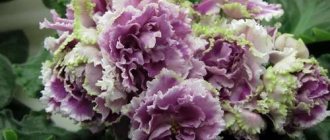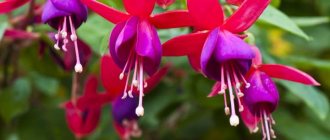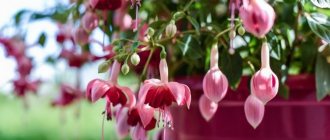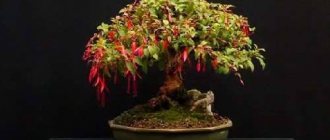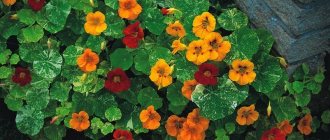Graceful, bright, attractive fuchsia flowers hang like jewelry among the delicate foliage. They resemble little forest fairies, dressed in dresses of various colors: red, white, pink. The unusual shape is the reason for the appearance of another popular name - “elf flower”. The plant requires simple care, although to avoid problems it is worth familiarizing yourself with its features. For example, how to care for fuchsia in order to fully reveal its varietal characteristics.
Curious pedigree of the plant
Natural types of fuchsia are witnesses to the history of the powerful Indian people, the successor of the traditions of the Inca Empire in South America. This beautiful flower was brought to Europe from Chile in the 18th century. Straight to the English royal court.
The genus of plants Fuchsia belongs to the fireweed family (Onagraceae) and has 107 species growing in natural conditions. Breeders have created hybrid fuchsia, many of its varieties, representing an incredible palette of petals.
Interesting facts:
- The Frenchman C. Plumier, who discovered the species in 1696 on a scientific expedition to the Greater Antilles, gave it the name in honor of L. Fuchs, a German botanist.
- In 1853, the first fully double fuchsia variety was developed.
- The father of genetics, Gregor Mendel, called this flower his favorite plant and chose it for his coat of arms.
Wild fuchsias are annual or perennial plants that live on the edges of tropical forests at altitudes of up to 3000 m in the light shade of tall trees. Flowers in the room also require high humidity and shading from the scorching sun. Getting acquainted with tips on how to grow fuchsia should begin with studying the varieties and growing conditions.
Bush and ampel forms of fuchsias
All fuchsias are characterized by thin branches. Young stems have a reddish tint. The leaves are oval or ovate, with small teeth along the contour. The upper part of the branches is strewn with large flowers. Or rather, they hang down, resembling the silhouette of a ballerina, an elf or a lantern.
The calyx of fuchsia flowers is corolla-shaped, brightly colored. It has four pointed, strongly bent sepals. The corolla is tubular, often has the shape of a fluffy skirt, the stamens are long. The flowers vary in size and color, and the color of the sepals usually contrasts with the corolla.
The following varieties of fuchsia (group) are distinguished:
- bush;
- ampelous (hanging);
- semi-ampel.
The division into groups is somewhat arbitrary. Most fuchsias have both erect and drooping shoots, i.e. they are semi-ampeloid. Bush plants grow upwards and rarely droop.
In some classifications, fuchsia varieties are divided into bush and creeping forms. Creeping or hanging varieties are grown in hanging baskets, flowerpots, and used to decorate the walls of rooms, verandas and terraces.
Low-growing fuchsias in a pot are resistant to dry air and are suitable for beginner gardeners.
How to care for fuchsia at home
Graceful bushes bloom profusely and reproduce easily. Usually, growing and caring for fuchsia at home does not cause difficulties. This is why the plant has gained great popularity among gardeners in many countries.
The only whim of fuchsia is that it should not be rearranged or rotated during flowering. It is also recommended to avoid heating and drying out the root ball.
Temperature
Optimal temperature conditions during the growing season: during the day from 20 to 24°C, at night 15–18°C. The fuchsia flower needs fresh air. The beauty feels good in the summer on a loggia or balcony, where the plant needs to be shaded at midday and protected from drafts.
Lighting
The ideal location is windows facing southeast and southwest. Western and eastern windows, a balcony, a terrace are suitable. If you provide shade during the summer at noon, you can grow it on the south side. Fuchsia varieties with light-colored flowers can withstand the sun better.
Completely shady places are not desirable for the plant. Although fuchsia is patient even with them. Just when choosing a house flower for a north window, do not expect abundant and long-lasting flowering.
Watering
Fuchsia is a moisture-loving plant, sensitive to waterlogging and drying out of the soil. However, water should not stagnate in the pan. In summer, watering is required every 1–2 days, in dry weather - daily.
During the warm period, it is recommended to water in the evening, in autumn and winter - in the morning. From the beginning of May to the end of August, you can add fertilizer solutions weekly when watering. After flowering, watering is reduced.
Humidity and spraying
Moisture is useful for the plant not only as nourishment for the roots, but also in the form of spraying. In drought and simply hot weather, spray 2-3 times a week or more often, during rainy periods - less often. Proper care of fuchsia is to use settled water for watering and spraying.
Feeding
What and how to feed fuchsia is decided depending on its condition and time of year. If you have ready-made liquid fertilizer for flowers, then it is diluted with water 1:1 and applied 1-2 times a week. They begin to feed after the plant emerges from dormancy.
During the period of active flowering, it is recommended to use a fertilizer containing nitrogen-phosphorus-potassium (NPK) in a ratio of approximately 2:1:3. Nitrogen promotes rapid growth of shoots. However, during flowering, the element causes increased growth of vegetative organs, and fewer buds are formed.
Pruning and shaping the bush
The ampelous or compact bush form of fuchsia is not only a sign of a variety or hybrid. Pruning and shaping the crown allows you to control and direct the growth of your green pet. This is one of the difficult moments in caring for fuchsia. The plant should be pruned annually, as the old stems become woody and fewer flowers develop on them. When forming a crown, it is convenient to use a support.
If you cut or pinch the top of a branch, 2 dormant buds wake up in the leaf node below the cut point. This allows the grower to create branching depending on the desired shape of the crown, the availability of free space for growth and other related circumstances.
Trimming sequence:
- If the shoot has one growth point, then 3–4 nodes are left on it.
- After the third or fourth internode, the stem is cut off at a distance of 1 cm from the node.
- From this extreme node, its awakened buds, 2 new shoots grow.
- On regrown shoots, 1–2 internodes are left, and a cut is made higher up.
- In place of new cuts, 2 more branches grow.
Fuchsia blooms 60–80 days after pruning. To ensure uniform growth, the pot is periodically rotated relative to the light source. During flowering, they try to disturb the plant less, since a change in location leads to the fall of the buds.
Care during the winter dormant period
The dormant period of fuchsia lasts 3–4 months - from November to February. At this time, the leaves of the plant may fall off. It is necessary to properly care for fuchsia at home in order to maintain the vitality of the beauty. After flowering ends, stop feeding, reduce watering, and cut the shoots to ½ length.
The plant is placed in a bright place with a temperature from 7 to 11–13°C. This could be a winter garden, a greenhouse, an attic, a bright corridor. The earthen clod is not allowed to dry completely. In February, fuchsia is exposed to light and watered more often.
Planting fuchsia at home
What is good about fuchsia is that growing and caring for a flower at home does not involve much difficulty. There are many garden varieties that can be kept outdoors during the warm period from early May after the threat of frost has passed. In flower beds they take root instantly, grow vigorously and can bloom for several weeks. The bushes that have been hardened by the first light autumn frosts are dug up and taken indoors for the winter.
Interesting types of fuchsia for planting and care at home:
- Tall Australian fuchsias - Matilda, Walsing, Adalbert Bogner, Ballet Girl, Comet, Gillian Anthea.
- Sapphires and Diamonds (varieties with white-blue and white-violet flowers) - Blue Satin, Capri, Ultramarine, Deep Purple, Princess Kaja.
- Terry forms - Florentina, Brentwood, Caspar Hauser, Charelke Dop, De Brommel, Sarah Jane. The Royal Mosaic variety, which has double purple petals with pink highlights, is prized among lovers.
- Container hanging ampel-type fuchsia, grown in hanging pots and baskets - Marinka, Southgate, Pink Galore, Swingtime, Dark Eyes, White Galore.
- Three-leaved fuchsia - a shrub with home care reaches up to half a meter in height, the color of its flowers is bright coral.
- Winter-hardy fuchsia varieties for growing and caring at home (withstand frosts in the middle zone under cover or under snow cover) - Bacon, Garden News, Constance.
Fuchsia from seeds at home
This method is used to breed new varieties, but is rarely used in home gardening, because fuchsia, when grown from seeds, may not retain its parental qualities. Artificial crossing is carried out using a brush to transfer pollen from the father plant to the mother flower, removing the anthers on it before the buds begin to bloom. After pollination, it is covered with a cloth of thin material until the rudiment of the fruit appears.
Growing and caring for fuchsia seeds at home is done in containers into which soil seasoned with nutrients is poured. Plant the seeds in early spring from March to April, sprinkling them lightly with soil. Peat briquettes are suitable, allowing you to avoid damaging the delicate roots during replanting. The room temperature is maintained at about 18°C. In containers, seedlings appear in three weeks.
Growing fuchsia from cuttings
Vegetative propagation almost always gives successful results; even beginners can do this work. In just six months you will have an excellent and beautiful fuchsia; growing and caring for them at home using cuttings is the cheapest and easiest way to propagate these plants. To work, you need to have your own mother plant or a fresh cut shoot purchased from people you know. The easiest way to take fuchsia cuttings at home is to root them in water with pieces of charcoal. In good conditions, the roots of a seedling appear in 10-15 days.
How to propagate fuchsia at home?
Studying the process of how fuchsia reproduces at home is a simple and exciting activity. There are several nuances here that do not require much scientific knowledge. You will need a suitable cutting or leaf on a petiole with part of a shoot and an axillary bud, a glass, a plastic bag, and a little sphagnum moss. We offer short and simple instructions for growing and caring for fuchsia cuttings.
How to root a fuchsia shoot at home:
- We cut off the apical shoot with several leaf axils (2-3) at an angle of 45°.
- After 10 minutes, the cut is sprinkled with a root formation stimulator (Epin, Zircon).
- Sphagnum moss, which can retain liquid well, gives good results.
- Pour the mixture into a plastic cup and immerse the cutting into it 2-3 cm.
- Cover the top of the glass with a plastic bag, creating an impromptu greenhouse.
- Place the container on the windowsill, covering it from direct sun. The optimal rooting temperature for fuchsia is about 22-25 °C.
- The greenhouse is ventilated a couple of times a day. Roots form at home after two weeks.
- The seedling with roots is transplanted into a pot with soil. For the first time, it is covered with a bag, but it is no longer tied tightly.
- The greenhouse is removed after active growth of shoots begins.
Fuchsia transplant
The plant is replanted if the roots completely fill the pot. Before transplanting an adult fuchsia, pruning is carried out. Healthy shoots are reduced by 30% of their length, and diseased branches are removed. Remove the plant from the pot and check for damaged, rotten roots that need to be trimmed.
What kind of pot is needed for fuchsia
The dishes should not be deep, because the roots of the plant are superficial. Choose relatively wide pots and flowerpots - ceramic or plastic.
The pot should be proportionate to the root system, but with a margin of 2–3 cm. Young plants are planted in containers with a diameter of 12 cm.
Soil mixture
Fuchsia is suitable for neutral or slightly acidic soil (pH from 5.5 to 6.5). The substrate must be well drained. If there is a universal nutrient soil, then add sand, ash or perlite to it.
When planting and replanting, drainage is placed at the bottom of the pot under a layer of substrate - ceramic shards or expanded clay. If you prepare your own soil mixture, you need to take leaf soil, peat and sand in a ratio of 2:1:1/2.
Planting at home
Ampelous fuchsia should be planted 2-3 cuttings in one container:
- Drainage is placed in the pot, the substrate is filled, holes are made according to the shape and size of the root system of young plants.
- Rooted shoots or grown seedlings are taken out of the cups and planted without deepening the central stem.
- Watered.
- If the fuchsia is weak or the root is poorly developed, cover it with a glass cap or cellophane.
- Place in a slightly shaded place.
Strong plants with a powerful root system only need protection from bright sun for 2-3 days and regular spraying of the crown.
Soil requirements
Ampelous fuchsia loves soil with a slightly acidic reaction. It should be structured, loose, and allow water and air to pass through well until the next transplant.
You can use a ready-made substrate for violets or geraniums. Many gardeners who practice intensive care and do not forget about fertilizing grow fuchsias, including hanging ones, in a mixture of peat and coconut fiber. The last component is needed so that in case of accidental drying, you do not place the pot in a bucket of water - peat tends to clump together, dry peat does not absorb liquid well, and coconut fiber absorbs it instantly.
If the owners prefer soil substrates, you can mix equal shares:
- turf soil;
- rotted leaves;
- humus;
- sand;
- sour peat.
Choosing a pot
It is better to grow ampelous fuchsias in ordinary containers. And then put them in a flower pot or hanging basket and take them outside to the balcony.
The container should be proportional to the root, quite close, but containing at least 1 liter of substrate per adult bush. Flowering will begin only when the adventitious shoots entwine the clump.
You can hear the objection that ampelous fuchsia perfectly forms buds in large flowerpots. But not one, but several plants are planted there at once, otherwise it is difficult to obtain a lush, beautiful bush, especially with cascading ampelous varieties.
It is better to take a plastic pot for fuchsia, with several large holes; be sure to place drainage at the bottom. It is needed:
- so that excess moisture does not stagnate in the root area;
- to improve aeration, which is no less important.
The design of a flowerpot or hanging basket is not particularly important. If you care for the ampelous fuchsia correctly, it will cover the walls with flowering vines.
Reproduction
Fuchsias are easily propagated at home by cuttings or separating root shoots. Experienced flower growers and breeders use seed sowing. However, during seed propagation, varietal qualities may be lost. There is also a downside: you can cross-pollinate, get seeds and develop new flower hybrids.
Cuttings
Fuchsia is propagated by cuttings at home during the growing season. In summer and early autumn they are planted in pots and placed in a permanent place until the beginning of winter. Such plants usually bloom earlier than those that are rooted in the spring. Cuttings obtained by pruning a bush are perfect.
How fuchsia propagates by cuttings:
- Cut a young shoot 10–15 cm long immediately below the leaf node, use the tip 7–10 cm long, a large leaf with a petiole.
- The lower leaves on the cuttings are removed, leaving no more than 3 pairs.
- The prepared material is placed in pots with a diameter of 6–7 cm or plastic cups filled with a wet mixture of equal parts of peat and sand.
- Cover with a plastic bag with holes for air exchange.
- Take the cuttings to a warm, bright place, water them, and ventilate them regularly.
- The first roots appear after 10 days, and fully developed roots form within 3–4 weeks.
You can root cuttings in water or wet sand. It is important that there is no overheating. At 23–25°C and high humidity, cuttings may rot. As soon as the young plants reach a height of 6–8 cm, the tip of the shoot is pinched. This promotes the development of bushes with 4–6 branches.
Propagation by seeds
Experienced flower growers interested in obtaining new hybrids share their experience on how to plant fuchsia seeds and how to properly care for the sprouts. This is a labor-intensive and time-consuming procedure. Therefore, amateurs should think twice before propagating fuchsia by seeds at home. The result is not always positive.
The seeds are sown in a plastic container with a damp substrate and covered with a transparent lid or film. Place the container in a warm, well-lit place, but not in direct sunlight. The soil is constantly sprayed with water. Young plants are planted in separate pots or flowerpots after 6–8 weeks.
Fuchsia - flying ballerina
HOW TO CARE FOR FUCHSIA. FEATURES OF GROWING
Growing fuchsia is not difficult, just follow the following care rules:
Temperature. Relative coolness is preferable for home fuchsia than the scorching sun and heat. The ideal temperature is +18-20 degrees in summer and slightly below +15 degrees in winter. It is better to think in advance where to place the plant. In winter, you can place the pot on the northern windows, away from radiators, and in summer you can take it out into the garden or balcony, into the shade.
Lighting. For normal flower growth, diffused sunlight is sufficient. You can place fuchsia on windows in any direction, except south; the plant can get burned from direct rays and lose its leaves. Do not move a pot of blooming fuchsia. Otherwise, she will drop all the buds.
Watering. In spring and summer, the flower is watered abundantly and regularly. The soil should not be allowed to dry out, so you need to ensure that the top layer of the substrate dries out. In autumn, watering is reduced somewhat. When switching to a “cold” wintering, water very rarely. If the plant remains in the room - a little more often. Before watering, the water needs to stand. Fuchsia prefers high air humidity. Therefore, spraying will only be beneficial. Fertilizers. Fertilizers are applied only in spring and summer. Once every two weeks, water with water with the addition of complex fertilizer for flowering plants.
Transfer. It is better to replant in the spring, when the plant is gaining strength after winter. You can choose an earthen mixture in a specialized store or prepare it yourself. For example, fuchsia grows well in the following substrate: turf and leaf soil, peat, sand and humus (in equal parts). It is convenient to replant using the transshipment method so as not to damage the roots. The plant, together with a lump of earth, is transferred into a pot, which is only a few centimeters larger than the previous one. A layer of drainage is poured onto the bottom.
Trimming. It is suggested that fuchsia should be pruned twice a year. The first is after flowering, in early autumn. All branches that bloomed are pruned 2 cm above the dormant buds. The second formative pruning is carried out at the beginning of winter.
Reproduction. At the end of winter - beginning of spring, fuchsia is easily propagated by cuttings. A shoot measuring 5-7 cm is cut off. The cut site of the cutting can be treated with root or other growth stimulant. But even without this, the branches easily take root in water or wet sand. After about 20 days, when roots have formed, the cuttings are planted in small pots. It is better to plant two or three cuttings in one pot, so the bush comes out fluffy and will bloom faster. Propagation by seeds is preferred by breeders and experimental gardeners. Fuchsias from seeds are unlikely to retain the characteristics of the mother plant. In addition, there is a risk of self-pollination or pollination by insects. Otherwise, growing fuchsia from seeds is similar to growing other plants. The seeds are dried for 1-2 days, planted in a wet substrate, and a greenhouse is created. In good light, you can expect germination in a couple of weeks.
Diseases and treatment
Indoor fuchsia under optimal growing conditions is rarely attacked by insects, pathogenic fungi and bacteria. The main problem is the so-called “care diseases,” when a flower suffers from a lack or excess of moisture, nutrients, or light.
Root rust
Fuchsias are affected by the fungus Pucciniastrum epilobii. A diseased plant can be recognized by the appearance of yellow-brown to rusty-red spores on the leaves. In order not to miss the symptoms of trouble, you need to know how to care for fuchsia from the first days of its appearance in the house.
Copies purchased in a store or donated are pre-placed separately from the entire collection. All plants are regularly inspected and infected ones are isolated. The affected parts are removed and destroyed. If there is severe infestation, treat with a suitable fungicide, for example Bona Forte.
Various soil fungi cause root diseases. Damage is promoted by complete drying of the root ball, followed by abundant watering and stagnation of water in the pan. To combat root rust, fungicide solutions are used to water the substrate. When transplanting, the roots are washed in a solution of potassium permanganate.
Gray rot
The disease is caused by the fungus Botrytis cinera. When a gray coating appears, rotting leaves and shoots of fuchsia, all diseased parts are removed. At the same time, they provide better ventilation of the plant (without drafts), reduce the amount of watering, and stop spraying. Fungicidal drugs are used.
Lack of nutrition
Nutrient deficiency is manifested by early dropping of buds, weak, short flowering. If the pot is small for fuchsia, then the roots grow into the drainage hole, and young shoots and flowers develop worse.
Overfeeding plants or using pots that are too spacious is also undesirable. Then the fuchsia begins to increase the green mass to the detriment of flowering. Attention and moderation are important in care.
Pest protection
Aphids and whiteflies are more likely to attack fuchsia than other insects. Pests significantly complicate caring for fuchsia at home. From time to time it is necessary to inspect the plants to identify infection. If there are few pests, then the affected parts are cut off and destroyed. Chemical treatment is carried out when mechanical methods of control no longer help. Spray infected plants several times. Breaks between treatments are from 5 to 7 days.
Biopesticide Fitoverm is effective against aphids, sciarids, thrips, spider mites, and springtails. Treat plants, flower pots, flowerpots, window sills and shelves with Bona Forte insecticidal spray. In the greenhouse, greenhouse and outdoors, insecticides Actellik, Aktara, Fufanon-Nova are used in accordance with the instructions for the preparations.
Fuchsia - home care
When it comes to caring for fuchsia in your home, you need to focus on the conditions in the apartment. Compact shapes, resistant to bright light, suitable for window sills. Shade-tolerant species can be placed in pots inside the room. Ampel varieties feel good on suspended structures, standard ones - on a table or a special stand. If you do not know the acquired variety, then create average conditions for your fuchsia, adjusting its formation as it develops and taking into account the growth force.
Homemade fuchsia flower - watering
In the absence of fertilizers, the plant can develop, but without water, any organism will quickly wither. When studying the problem of how to care for fuchsia at home, you need to pay special attention to watering. Excess moisture leads to rotting and disease, but it is advisable to ensure that the soil in the pot is completely saturated with liquid. Watering is carried out when the top layer of soil dries. Blooming fuchsias require this procedure more often when cared for in summer. In hot weather, water the plant every 3 days or more often.
Fuchsia - feeding at home
Fertilizer application is beneficial during the growth period - from April until the arrival of cold weather. When caring for a fuchsia flower, it requires one feeding with complex preparations for 2 weeks. In winter, the plant is in a dormant stage and does not need stimulation. If you have transplanted, you should not rush; resume feeding a month after the fuchsia has adapted to the new conditions. Both root and foliar methods of applying fertilizers are suitable.
Fertilizers are not applied to dry soil; before this procedure, the soil should be watered a little. To stimulate the formation of buds, the crown is treated with Zircon, then the fuchsia needs phosphorus-potassium fertilizers. Balanced fertilizers of old and new brands for flowers are suitable - “Spring Effect”, “Planta Miracle-Growth”, Pokon, and other proven preparations.
Popular types of fuchsia with photos and names
Having become familiar with the features of caring for fuchsia, it’s time to move on to choosing a variety for your home.
Bushes of small-flowered wild fuchsia species cannot be found in flower shops today. More than 12,000 varieties have been created, and this work continues.
The most important directions of modern breeding: creating plants that are more resistant to low temperatures, with blue, pure yellow or perfectly white flowers.
Initial species for breeding new varieties:
- Bolivian (F.boliviana);
- thin or graceful (F.macrostemma);
- brilliant (F.fulgens);
- sparkling (F. splendens);
- trifoliate (F. triphylla);
- hybrid (F. hybrid).
Old and new varieties are combined into groups. Simple flowering and double, bush and hanging fuchsias are widely represented. Flowers are semi-double, double and densely double. The photo shows an example of a densely double variety.
Description of some varieties:
- Bicentennial. Large double flowers consist of white and orange sepals, a red skirt with orange strokes. After flowering, small berries are formed.
- La Rosita. The bush is compact, with large double flowers that look like pink buds. The skirt is initially lilac, but as it blooms it turns pink.
- Margarita. The bush is dense, the flowers are large, densely double. The sepals and skirt are creamy with a pinkish tint.
- Early flowering variety. The flowers are semi-double, consisting of a bright pink calyx and a black and purple skirt.
- Rohees New Millennium. The bush is strewn with double flowers with red sepals. The skirt is dark cherry.
- A variety with densely double multi-tiered flowers. The sepals are red, bright, the skirt is white with red-pink veins.
- The variety is semi-ampelous. The shoots, which are erect when young, droop over time, so the adult plant looks like an ampel. The flowers are quite large, densely double. The sepals are light with a pink tint, the skirt is lavender in color.
Fuchsia Marinka (Fuchsia Marinka)
An ampelous variety characterized by semi-double flowers. Sepals are bright scarlet. The skirt is red with a subtle purple tint. An unpretentious variety that blooms profusely.
Fuchsia Golden Swingtime
Bush or semi-ampelic variety with huge, densely double flowers. Fuchsia Swingtime, like many other representatives of the species, is two-colored. The plant has red sepals and stamens and a white skirt.
Delicate fuchsia (Piannes Berg)
An ampelous variety with large flowers. The sepals are pink and white, the skirt is terry, white with a cream tint. The petals curl, which gives the flowers an unusual appearance.
Fuchsia Millennium
Ampel and semi-ampel variety, late flowering. The flowers are large, double. The sepals are red, the skirt is blue-violet, almost black. Following the Millennium, a new millennium appeared.
Fans of dark-colored flowers will also like Fuchsia Blackie and the Lady in Black variety.
Bush flower Margarita (Fuchsia Margarita)
The variety is grown as a bush or hanging plant. The flowers are large, densely double, almost round in shape, “waxy” in appearance. Color: white-pink and cream.
Dark Eyes Fuchsia
A variety of indoor plants that is universal in form and care, which can be grown both as a creeping flower and in the form of a beautiful bush using a support. The bright contrasting color of the red sepals and the blue-violet skirt create the image of a festively dressed plant.
Various, bright fuchsias decorate a collection of indoor plants, a cozy terrace and a greenhouse. It is not difficult to grow flowers if you observe the temperature regime, regular watering and timely fertilizing. The main thing is to take the time to acquire knowledge and skills for proper care and reproduction. Fuchsia, like a fairy fairy, will thank its owners and guests with lush blooms.


